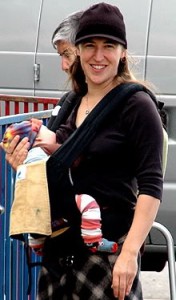 People often wondered why I like to recommend babywearing to mothers and my clients. Even if they were not breastfeeding, I would still recommend babywearing. Breastfeeding and babywearing to me is like bread and butter! It just goes so well together! Both are learnt skills and require lots of practice! Personally, I was introduced to babywearing when I had my 1st child in 2001. Back then, I was only familiar with the crotch carrier but my maid used to carry my son around in a sling made of a piece of batik cloth (which is commonly known as a “gendong”). I was fascinated on how quickly she could put the piece of cloth on and by how calm my son Adam would be whenever he was in the “gendong”. When it came to calming him down, it really helps. However, I did not like the crotch carrier and did not do very well with the gendong as I was not able to tie it properly most of the time! It was not until 2003 when I had my 2nd child Alysha that I was introduced to a fantastic carrier called a Ring Sling (RS). Wearing Alysha was probably the single most important decision I made as a parent back then. Alysha was a rather fussy baby. She had a reflux problem as well and the only thing that seemed to help was to “wear” her. Without the sling, it was almost always like a drama with a bad ending. She would cry and spit out so much that I always had to keep a spare blouse or shirt with me whenever I went out. I learnt that wearing her in an upright, tummy-to-tummy position helped to keep her feed down but more importantly it made her happy! And of course the following equation applies:
People often wondered why I like to recommend babywearing to mothers and my clients. Even if they were not breastfeeding, I would still recommend babywearing. Breastfeeding and babywearing to me is like bread and butter! It just goes so well together! Both are learnt skills and require lots of practice! Personally, I was introduced to babywearing when I had my 1st child in 2001. Back then, I was only familiar with the crotch carrier but my maid used to carry my son around in a sling made of a piece of batik cloth (which is commonly known as a “gendong”). I was fascinated on how quickly she could put the piece of cloth on and by how calm my son Adam would be whenever he was in the “gendong”. When it came to calming him down, it really helps. However, I did not like the crotch carrier and did not do very well with the gendong as I was not able to tie it properly most of the time! It was not until 2003 when I had my 2nd child Alysha that I was introduced to a fantastic carrier called a Ring Sling (RS). Wearing Alysha was probably the single most important decision I made as a parent back then. Alysha was a rather fussy baby. She had a reflux problem as well and the only thing that seemed to help was to “wear” her. Without the sling, it was almost always like a drama with a bad ending. She would cry and spit out so much that I always had to keep a spare blouse or shirt with me whenever I went out. I learnt that wearing her in an upright, tummy-to-tummy position helped to keep her feed down but more importantly it made her happy! And of course the following equation applies:
A happy baby = NOT a fussy baby
A happy baby = NOT spitting up!
I realised back then that a lot of what I did used to be based on trial and error. If it worked, it worked. Breastfeeding while babywearing was (*sigh*) a lifesaver for me! I could literally do anything while wearing my baby (okay, well, almost everything! J )
When Aidan came along in 2006, I was introduced to other options or a “world of possibilities” of wearing my baby and well, let’s just say the rest is history!
So, what is babywearing and how does it help parents?
As defined in babywearinginternational.org — “Babywearing” simply means holding or carrying a baby or young child using a cloth baby carrier. Holding babies is natural and universal; baby carriers make it easier and more comfortable, allowing parents and caregivers to hold or carry their children while attending to the daily tasks of living. Babywearing helps a new dad put a fussy newborn to sleep. It allows a new mom use both hands to make a sandwich. It lets an experienced parent or caregiver carry a baby on her back and wash the dishes, do the laundry, take a hike, or weed the garden, all while keeping the baby safe and content.
For centuries, women all around the world have been wearing their babies while performing their daily tasks. In the modern world we live in today, Babywearing allows breastfeeding on the move so that busy mothers can nurture their babies with the best nutrition; yet continue their active lifestyles.
Babywearing is convenient. Breastfeeding while babywearing makes life easier for the mother of a breastfeeding baby especially if the baby is going through a growth spurt and feeds every now and then. Breastfeeding while babywearing allows mother to be on the go and get things done around the house while meeting her infant’s breastfeeding needs. It’s convenient outside the house, too. If you are shopping with the baby and need to feed in public, breastfeeding discreetly is very easy while wearing baby. Because baby feels comfortable in the sling, he is content feeding there, even in a public place. I used to breastfeed while doing my grocery shopping. People would often not realise I was carrying a baby until they saw something wiggling in the “bag” I was carrying (they always think it’s a bag!)
Babywearing makes sibling care easier. Breastfeeding in the sling is especially valuable when there is a new baby and an older toddler. Feeding the newborn in the sling, gives mother two free hands and mobility to also attend to the toddler. It also lessens sibling rivalry and allows both children to be cared for well by the mother.
Babywearing helps a mother and her adopted baby bond. It also helps babies who refuse to go to the breast (nursing strike/breast refusal). In our practice, we encourage mothers who adopt babies and babies who are going through what we call “breast refusal” to do a lot of skin-to-skin contact. It helps with the process of induced lactation as well since skin-to-skin eventually may lead baby to the breast. Even if induced lactation is not successful, the bond developed from babywearing is a beautiful, enriching experience and lasting memory for mom!
Babywearing calms fussy babies & problem suckers. Some babies are fussy for various reasons. Babywearing helps to calm babies and they tend to cry less when worn. Some babies breastfeed better on the move, especially those problem suckers who need movement to organise their sucking. Babies with suck problems called “tonic bites” and back archers often breastfeed better in a sling because of the organising effect babywearing has on their entire physiology. As the baby’s whole body relaxes, so do the suck muscles. For babies who suck better on the move, first position baby in the sling in order to achieve proper latch-on, and then quickly begin walking. Trust me, it’s good exercise for mom too!
Babywearing helps the slow-weight-gaining baby. It only makes sense to wear a baby to facilitate on demand feeding. The nearness of mother to baby enables and encourages mother to read and respond to baby’s feeding cues more promptly. Baby is also always near the source of milk and comfort, he does not have to waste energy asking for the mother; baby can use this energy to grow. Babies will be able to feed more frequently and in a more relaxed, comfortable way in the sling, mom gets to focus on simply enjoying the moment and not feeling stressed about it. Research proves that weight dramatically increases if this method is used.
TIPS FOR BABYWEARING:
- Plan your wardrobe if you’re planning to breastfeed while babywearing. Lifting your shirt while wearing a baby is difficult and can be unflattering as well! A button down shirt, low cut shirt will come in handy. Otherwise, a nursing top with a pull-aside or dropcup nursing access is very helpful.
- Know the basics & Practice at home before you go for an outing with baby! Practice in front of a mirror and get to where you are comfortable making adjustments and moving around.
- Don’t be discouraged if one carrier doesn’t work well for you. Remember, there are many types out there and most work for nursing.
- 4. More importantly, use common sense! Always observe your baby and practice safe babywearing. If you don’t feel comfortable after making adjustments to the straps or fabric, do not continue. Keeping the baby in the carrier and preventing any suffocation is the number one priority. You can always take the baby out to nurse them if you need to. Remember, safety first!
Words of Wisdom:
“Holding a baby with a simple piece of cloth is a beautiful, ancient art that belongs to all of humanity. It must not be lost. Learn it. Then teach everyone you know.”
— Tracy Dower
Creator of The Mamatoto Project, Inc
Non-profit promoting babywearing
————————————————————
Prepared by Rita Rahayu Omar, BSc, CISA, IBCLC
Lactation Consultant, Susuibu.com Training, Consultancy & Educational Services
www.susuibu.com





